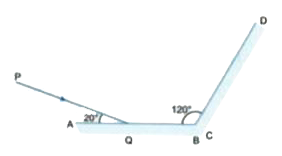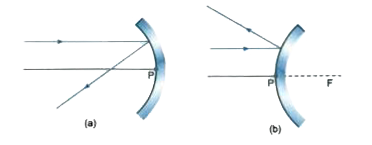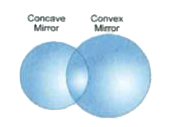HOTS (HIGHER ORDER THINKING SKILLS) from VK GLOBAL PUBLICATION PHYSICS (HINGLISH) LIGHT-REFLECTION AND REFRACTION for Class 10
| Class 10 | PHYSICS |
| Chapter | LIGHT-REFLECTION AND REFRACTION |
| VK GLOBAL PUBLICATION PHYSICS (HINGLISH) | HOTS (HIGHER ORDER THINKING SKILLS) |
| Medium | English |
| Academic Year | 2023-2024 |
Question 14
The ray diagrams given below show the paths of a ray of light travelling from a medium Minto different media 1, 2 and 3.

(a) In which of three media 1, 2 or 3 does light travel: (i) faster, (ii) slower than in medium M?
(b) Arrange the media 1, 2 and 3 in descending order of (i) speed of light through them, (ii) their refractive index.View SolutionQuestion 17
A student recorded the following data for the values of object distance and corresponding image distance while performing an experiment on real image formatio lens of power + 4 D. Two of these observations are incorrect. Without making any calculations, identify these observations and give reason for your choice.
 View Solution
View SolutionQuestion 18
The given ray diagram shows a ray of light PQ striking a mirror AB. The mirror AB and CD are at an angle of 120∘ with each other. The ray PQ strikes the surface of the mirror AB at point Q.
(i) Draw the complete path of reflection of the ray at mirrors AB and CD.
(ii) Calculate the sum of angles which the reflected rays make with the surfaces of mirrors AB and CD.
 View Solution
View SolutionQuestion 20
Playing with an old lens one morning, Ravi discovers that if he holds the lens 10 cm away from a wall opposite to a window, he can see a sharp but upside-down picture of outside world on the wall. That evening, he covers a lighted lamp with a piece of opaque paper on which he has pierced, a small hole 1 mm in diameter. By placing the lens between the illuminated card and the wall, he manages to produce a sharp image of diameter 5 mm on the wall.
What is the power of the lens ?View SolutionQuestion 21
Playing with an old lens one morning, Ravi discovers that if he holds the lens 10 cm away from a wall opposite to a window, he can see a sharp but upside-down picture of outside world on the wall. That evening, he covers a lighted lamp with a piece of opaque paper on which he has pierced, a small hole 1 mm in diameter. By placing the lens between the illuminated card and the wall, he manages to produce a sharp image of diameter 5 mm on the wall.
In the evening experiment , how far away from the opaque paper did he place the lens ?View SolutionQuestion 22
Playing with an old lens one morning, Ravi discovers that if he holds the lens 10 cm away from a wall opposite to a window, he can see a sharp but upside-down picture of outside world on the wall. That evening, he covers a lighted lamp with a piece of opaque paper on which he has pierced, a small hole 1 mm in diameter. By placing the lens between the illuminated card and the wall, he manages to produce a sharp image of diameter 5 mm on the wall.
How far apart were the card and the wall ?View SolutionQuestion 23
If the image formed by a lens for all positions of the object placed in front of it is always virtual, erect and diminished, state the type of the lens. Draw a ray diagram in support of your answer. If the numerical value of focal length of such a lens is 20 cm, find its power in new cartesian sign conventions.View Solution
All Exercises from VK GLOBAL PUBLICATION PHYSICS (HINGLISH) Class 10 PHYSICS LIGHT-REFLECTION AND REFRACTION
- NCERT INTEXT QUESTIONS
- NCERT EXERCISES
- VERY SHORT ANSEWR QUESTIONS
- SHORT ANSEWR QUESTIONS-I
- SHORT ANSEWR QUESTIONS-II
- LONG ANSWER QUESTIONS
- SOME IMPORTANT NUMERICALS
- HOTS (HIGHER ORDER THINKING SKILLS)
- SOME IMPORTANT NUMERICALS (FOR PRACTICE)
- PROFICIENCY EXERCISE (LONG ANSWER QUESTIONS)
- PROFICIENCY EXERCISE (SHORT ANSWER QUESTIONS-I)
- PROFICIENCY EXERCISE (VERY SHORT ANSWER QUESTIONS)



